Panasonic Lumix DMC-FZ70 Review
Panasonic Lumix DMC-FZ70 Introduction
The Panasonic Lumix DMC-FZ70 is a 16 megapixels digital camera with an ultra-wide stabilized 60X optical zoom lens, equivalent to 20-1200mm. This is the most powerful optical zoom ever built into a digital camera. Most importantly, this is the widest angle-of-view among fixed-lens models.
The unique lens of this ultra-zoom is paired with a high-speed CMOS sensor capable of full 1080p HD video capture at a smooth 60 FPS. Still can be captured up to 9 FPS at full-resolution and even 5 FPS with autofocus between frames. As prosumer camera, this Lumix offers full manual-controls and a class-leading number of external controls, plus a hot-shoe for add-on lighting.
The FZ10 is shaped like a miniature DSLR with a built-in small 0.2" EVF and large 3" LCD screen. A stereo microphone with an optional built-in wind-filter zooms along the lens to better capture sound from the scene being filmed.
The Panasonic FZ70 provides advanced photographic controls including full manual-controls, manual focus, choice of metering, custom white-balance, white-balance fine-tuning, bracketing and full manual-controls over video.
This express digital camera review analyses the ergonomics, usability, performance and image quality of the Panasonic Lumix DMC-FZ70.
Panasonic Lumix DMC-FZ70 Features
Sensor & Exposure
- 16 Megapixels CMOS sensor
- ISO 100 to 3200 sensitivity, 1 or 1/3 EV increments
- Auto ISO based on light-levels and movement
- 1/2000-8s Shutter-speeds for still images
- PASM Exposure modes for both stills and video
- Program-Shift in P mode
- Exposure-Compensation, ±3 in 1/3 EV increments
- Multi-Segment, Average and Spot metering
Lens
- 60X Stabilized optical zoom
- F/2.8 / 5.9 Maximum aperture
- F/8 Minimum aperture
- Ultra-Wide-Angle 20-1200mm equivalent
- 1cm (W) - 1.5 (T) Minimum focus distance
Image Parameters
- Automatic, 5 presetsDaylight, Cloudy, Shade, Flash, Incandescent, Kelvin and custom white-balance, 2 memories
- WB fine-tuning, 19 steps along 2 axis
- WB Bracketing, 3 frames, 3 step size along A-B or G-M axis
- Standard, Vivid, Natural, Monochrome, Scenery & Portrait Photo Styles
- Adjustable Contrast, Sharpness, Saturation, Noise-Reduction, 5 steps each
- JPEG Image, RAW Data or JPEG+RAW capture.
Focus
- Normal, Macro, Super Macro and Manual focus
- Single, Automatic, Tracking and Face-Detect focus-point selection
- Optional Prefocus
- Manual Focus assist
- AF Assist-Lamp
Drive
- Single-Shot
- 9 FPS Drive @ 16 MP, Maximum 3 frames
- 10 FPS @ 3 MP, Maximum 100 frames
- Continuous AF available for 5 or 2 FPS drive
- Self-Timer, 2s, 10s or 3-shot @ 10s
- Bracketing, 3 Frames, ±3 in 1/3 EV increments
- Flash Burst, Maximum 5 frames
Display & Viewfinder
- 3" LCD, 460K Pixels
- 0.2" EVF, 200K Pixels
- Adjustable LCD brightness, Contrast and int2-Axis: Red-Green, Blue-Yellow
- Optional Framing-Grids
- Optional Live-Histogram
Video
- 1920 x 1080 @ 30 FPS
- 1280 x 720 @ 60 FPS
- 640 x 480 @ 30 FPS
- 1/20000s Max Shutter-Speed
- MPEG-4 & AVCHD Codecs
- AF-S or AF-C focus
- Built-in stereo microphone
- Optional Zoom Microphone
- Optional Wind-Filter
Flash
- Flash Compensation, ±2 EV, 1/3 EV increments
- Auto, Auto Redeye, Forced, Redeye & Slow-Sync flash modes
- First or Rear curtain flash sync
- Optional Redeye reduction
- Standard Hot-Shoe
Connectivity
- HDMI (1080i) output
- A/V (NYSC / PAL) output
- USB 2.0 connectivity
Misc
- 4:3 (Native), 3:2, 16:9 & 1:1 Aspect-Ratio
- Customizable buttons, including AE-L/AF-L
- Panorama Assist Mode
- Panning Mode
- Built-in HDR
- 18 Scene Modes
- Face Recognition
- Lithium-Ion battery
- SDXC memory
Panasonic Lumix DMC-FZ70 Usability - How easy is it to use?
This ultra-zoom is designed along the lines of a miniature DSLR with a well-defined hand-grip, protruding lens barrel and combined viewfinder and flash housing hump. This makes the Panasonic FZ70 comfortable to hold and easy to keep steady. The electronic viewfinder protrudes nicely from the back to keep the photographer from pressing against the camera too much.
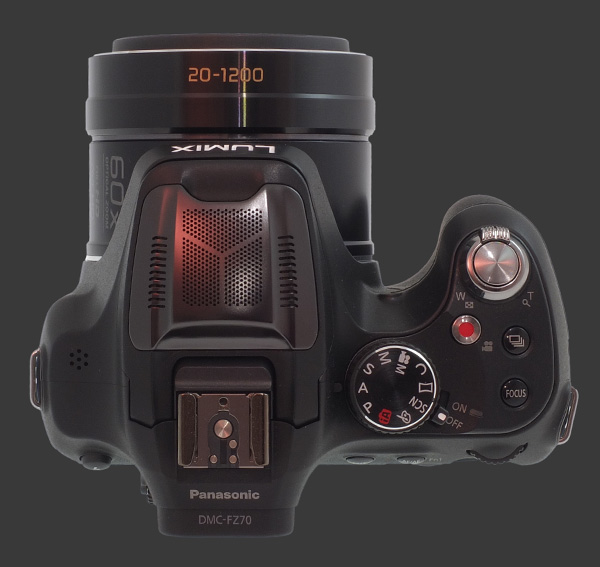
The shutter-release is located at the top of grip. It is a standard two-stage release with a soft halfway point. The FZ70 a variable speed zoom-controller wrapped around the release. The lens moves in very fine steps, making it possible to zoom with good precision.
Just behind the shutter-release is a dedicated Video Record button. Pressing it starts and stops filming almost instantly. Using this button, video can be recorded in any exposure-mode with two important caveats:
- Video exposure remains automatic in all modes except for Manual Video, as explained further.
- The EVF and LCD only preview the correct framing for video in Manual Video mode.
An optional overlay is available to lighten the area that would not be captured by video. This makes it possible to preview the framing for both images and videos with a slight loss of contrast for the outer edges of images.
Also behind the shutter-release is the Drive-Mode button. It brings up a menu of icons to choose among single-shot or one of the 7 continuous drive modes available on the Panasonic Lumix DMC-FZ70. There are speeds of 9, 5 and 2 FPS at full-resolution, with continuous autofocus available up to 5 FPS. A slightly faster 10 FPS speed is available at 3 MP. Flash Burst at an unspecified speed, up to 5 frames is also available.
Behind the Drive-Mode button is the Focus button. When pressed, the focus area can be moved or resized, with the 4-way controller or control-dial, respectively. In MF it acts as AF-On, meaning it performs one-shot autofocus.
The FZ70 features a mode-dial with 10 positions. The standard PASM exposure modes are all there. iA is the fully automated mode. There is a Sweep Panorama mode, an Effect mode plus a SCN position that accesses 18 modes. Of those 18, 14 are typical, while the following 4 are worth mentioning:
- Panorama - Helps line-up images for assembling a panoramic photo. The sequence of Images can be taken in any direction which is chosen upon entering Panorama Assist mode.
- HDR- Takes 3 shots with different exposures and blends them to simulate higher dynamic-range.
- Panning - Instructs the stabilizer to compensate only for vertical shake. There are Program and Shutter-Priority variants of this mode.
- 3D - Creates a 3D image from a series of shots while the camera is panned.
There is a Custom position on the mode-dial to recall settings. The final mode on the mode dial is Manual Movie mode. In this mode the Panasonic FZ70 can record video using any PASM exposure mode. Since the camera has to use an electronic shutter to record video, speeds up to 1/20000s are available.
Full 1920x1080 @ 30 FPS can be recorded with either the MPEG-4 or AVCHD codec. With AVCHD though, the stream is encoded as 60 interlaced fields per second. For true progressive output, use the AVCHD codec at 1280x720 which records 60 FPS. The 720p option for MPEG-4 records at 30 FPS. In Manual Movie mode, both the shutter-release and the dedicated video-record button start filming.
Just below the mode dial is a simple power slider with strong detents. This digital camera remembers settings except the Self-Timer. Optionally, it can remember the zoom position and manual focus distance. For repeated shots such as when capturing a time-lapse, it is very useful to have those settings remembered.
The last remaining items on the top plate are a popup flash, hot-shoe and stereo microphone. The microphone includes a built-in wind-filter which is activated from the Motion Picture menu. This stereo microphone has been designed to optionally zoom with the lens in an attempt to better record what is being filmed.
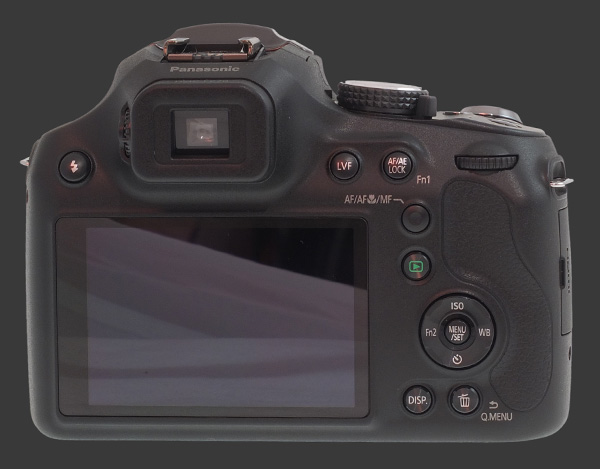
The back of the camera is dominated by a large 3" LCD with 460K pixels. Visibility of the LCD is superb with an awesome anti-reflective coating that does its job extremely well. It has a very good angle-of-view.
The view on the LCD and EVF is not Exposure-Priority until the shutter is press halfway. When pressed halfway, the preview is mostly correct, providing a good approximation of exposure. There is a note in the manual saying that the live-histogram turns yellow when the displayed image does not show the correct brightness. Since the displays are not Exposure-Priority, it turns yellow as soon as an EC is dialed-in! Also, it is far more often wrong than right. The issue is that it is based on the displayed brightness and not the metered one. This means that when the shutter is pressed halfway, the live-histogram frequently adjusts itself.
A tiny 0.2" EVF with 200K pixels is located above the LCD. The resolution is poor and the view is too small to see fine details. An LVF button to the left toggles between the EVF and LCD. Both framing and playback are possible using the EVF, with a configuration option to always use the LCD when entering Playback mode.
To the right of the LVF button, there is a highly customizable AE/AF-L button. First, it can be configured to lock, exposure, focus or both. Second, it can be set to do something entirely different. There are 13 options to choose from: Photo Style, Aspect-Ratio, Quality, Metering, AF Style, AF Mode, i.Dynamic, Guidelines, Video Recording Area, Remaining Display, Flash Mode, Flash Compensation and Auto Bracket. There so many direct buttons on the Panasonic Lumix DMC-FZ70, that the choice for this one could be anything!
These options are the same ones available for the left direction of the 4-way controller, shown below, so a few unusual merit some explanations:
- iDynamic is the name for Panasonic's contrast processing. It can be enabled at one of three levels. Higher levels increase shadow brightness and noise more.
- Video Record Area toggles the overlay mentioned earlier to allow framing of videos in image modes.
- Remaining Display toggles between showing the available space is number of shots of video duration.
- Auto Bracket lets one enable AEB in steps of 1/3 to 3 EV. The cameras always shoots 3 frames.
The Panasonic Lumix DMC-FZ70 has a single control-dial to set exposure parameters. The dial doubles as a button to cycle between parameters and EC as needed. In Program mode, it cycles between EC and Program-Shift. In Aperture-Priority and Shutter-Priority it toggles between the exposure parameter and EC. In Manual, it toggles between Aperture and Shutter-Speed. The modality of this system makes it easy to inadvertently set EC instead of the exposure parameter. In Manual Focus mode, the control-dial also cycles to set the focus distance.
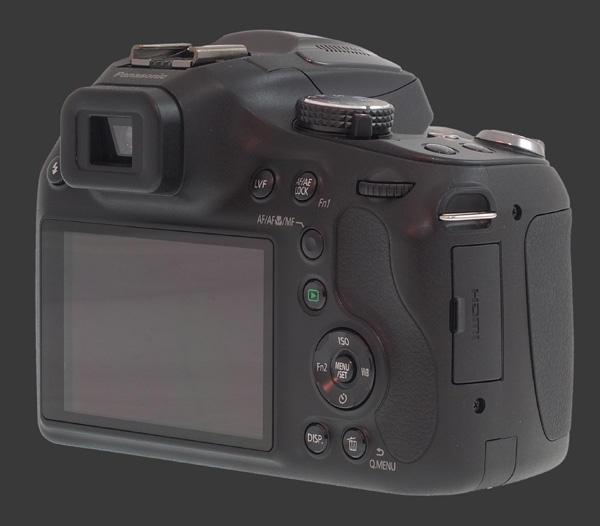
To the right of the LCD is another Focus button. This one selects between, AF, AF Macro, Macro Zoom and MF modes. AF Macro lets the camera focus down to 1cm from the front of the lens. Macro Zoom does the same but digitally enlarges the image further. This reduces image quality and is best avoided.
Just below, sporting a green label, the Playback button is within easy reach of the thumb. It behaves exactly as expected and the FZ70 is Shooting-Priority, meaning a quick tap of the shutter-release brings it back to capture mode.
The 4-way controller with central Menu/Set button is further down with each direction invoking a menu of options:
- ISO: Selects the ISO between 100 and 6400, plus one of two Auto modes. Standard Auto ISO mode selects an ISO based on light-levels. Intelligent Auto ISO selects and ISO based on subject movement.
- WB: Brings up a list of White-Balance options to choose from. Up/Down select the option and Right enters the WB Fine-Tuning screen which also allows for WB Bracketing with a press of the Disp button.
- Self-Timer: Selects between a 2s, 10s or triple 10s timer. One a shot is taken, the Self-Timer resets itself. It also prematurely resets itself when changing exposure modes and when entering the main menu, but not the Quick Menu. Tripod shooters are likely to find this rather annoying.
- Fn2: Activates one of 13 assignable functions as listed above.
Along the bottom edge of the camera are the Display button, which cycles over display modes, and the Delete button. In capture mode, Delete invokes an iconic menu that gives access to some key parameters. All those are also accessible via the standard menu system.
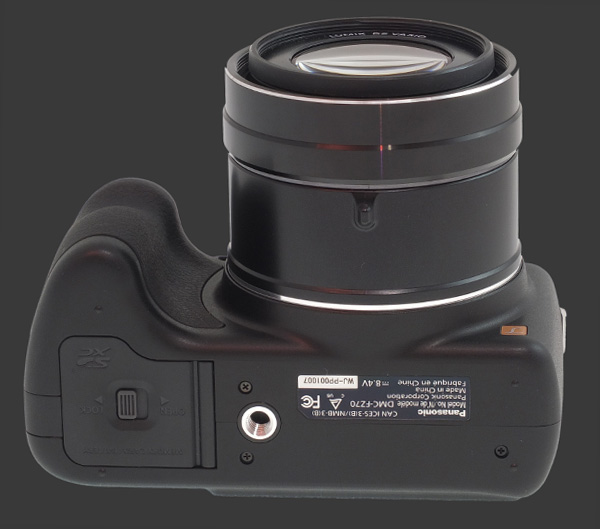
The bottom of the camera reveals a combined battery and memory compartment plus a metal tripod mount. The tripod mount is neither in-line with the optical center of the lens nor the center of gravity of the camera, making it less than ideal for usual tasks.
Handing of the Panasonic Lumix DMC-FZ70 is among the top of its class. All the most important function are accessible without entering the menu system and the buttons are easy to press with good clicking response. Dials have firm detents to prevent accidental changes. The modal interface to set EC and self-timer that reset are the only two major annoyances.
Panasonic Lumix DMC-FZ70 Performance - How well does it take pictures?
To pack a whopping 60X optical zoom lens in a camera this size, the Panasonic Lumix DMC-FZ70 uses a tiny sensor so that its 3.85-215mm lens equates to 20-1200mm in 35mm terms. This is the case for all current ultra-zooms and perfectly represents the compromise offered by this type of camera. This huge zoom range means flexibility while the small sensor sets expectations of limited image quality, particularly at the density of the this digital camera which captures 16 megapixels images. As a comparison, an 800mm which would give the equivalent field-of-view on an APS-C camera weighs at least 4kg and costs above $6000 USD.
The 60X optical zoom range of this digital camera is unequalled and gives it the widest angle-of-view among fixed-lens digital camera. This is immensely useful but difficult to achieve without much distortion. At the long end, the issue is getting effective stabilization which the FZ70 offers.
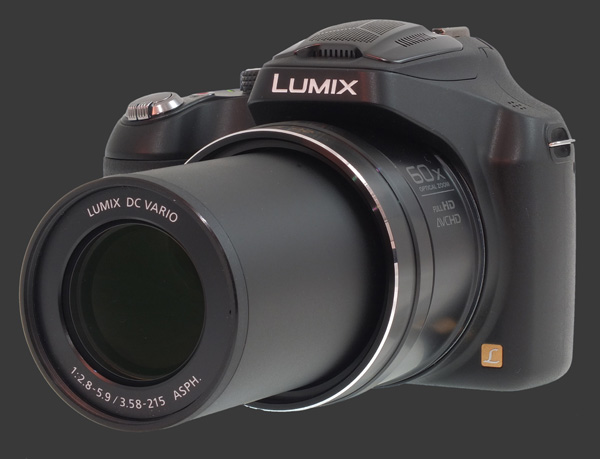
Starting at its base sensitivity of ISO 100, the Panasonic FZ70 shows noticeable image noise. However, details remain relatively well-preserved with Noise-Reduction dialed down. ISO 200 adds some slight softness and ISO 400 a little more. Still, both these settings remain usable for mid-size prints. ISO 800 is visibly softer with noise being kept low by aggressive noise-reduction, even at the minimum setting.
ISO 800 takes a dip in terms of quality with noise appearing and fine-details being destroyed by a a mix of noise and noise-reduction. This limits print to medium-sizes with a 9x12" coming out acceptable. ISO 1600 suffers yet another drop which is only usable for the smallest prints.
Anything beyond ISO 800 should be considered emergency-only. Noise is high and softness very pronounced at ISO 3200 which the maximum sensitivity of the FZ70. This is somewhat improved over previous generations, despite the high-resolution of 16 megapixels.
Color rendition is highly over-saturated by default in Standard style. Dialing Saturation down to the minimum of -2 improves things considerably. Still, there remains too much red regardless of settings which makes some people look pinkish in portraits.
Default sharpness however is reasonable but it be increased by +1 for added crispness without much artifacts. This interacts with this Noise-Reduction settings which only reduce sharpness minimally at low ISO.
Automatic white-balance is average. It copes well with various types lighting but not so consistently. Presets are hit-or-miss but the Custom White-Balance function is more reliable. Still, colors are never completely neutral. A bit of extra red is almost always present.
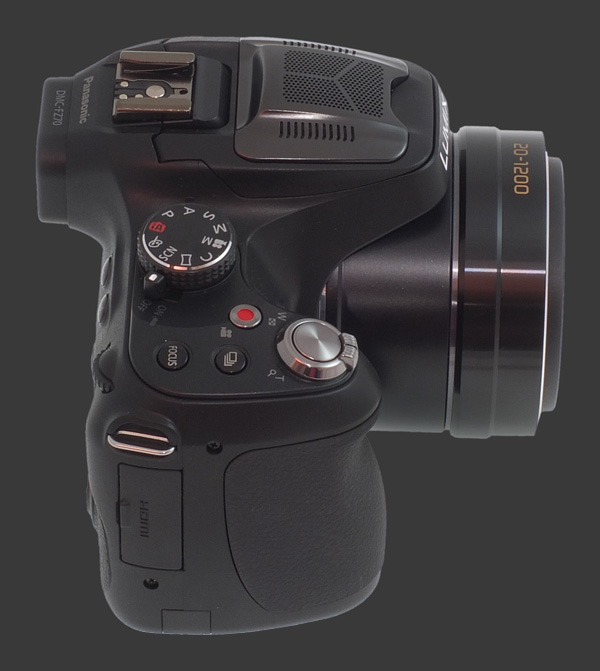
The Multi-Segment metering system used by this digital camera is about average. It prefers over-exposure over under-exposure and therefore clips bright highlights more often than it should. However, when dynamic-range is within the camera's ability, exposure is usually good.
Lens sharpness is impressive. Not impeccable but sufficiently sharp and rather consistent from edge to edge. There is a tiny bit of softness, probably due to noise-reduction, when seen at 100%. However, given 16 MP of resolution, this is not visible until large print sizes.
Optical distortion is extremely low and so are chromatic aberrations. There is no sign of vignetting at all either. Those shooting RAW may notice this not entirely true as the FZ70 correct for such aberrations internally.
The Panasonic Lumix DMC-FZ70 is somewhat faster than most fixed-lens cameras. The autofocus normally takes around ½s to ¾s to lock. It slows down towards the telephoto end of the zoom where it can take several seconds to lock. Still, it often manages rather than giving up.
In practice, focusing is almost always faster because of the Quick AF option which lets this camera pre-focus when camera movements slows down. This shortens battery-life a little. Unless low on battery or planning a long day shooting spree, it is probably best it to keep Quick AF enabled most of the time.
The following performance numbers characterize the performance of this camera:
- Startup: Normally 1½s. Excellent. If Lens Resume is enabled, it may take up to 5s.
- Shutdown: Between 2 and 4 seconds, depending on the lens position. Below average.
- Zoom: 3½s for the entire 60X zoom range. Impressive.
- Autofocus: ½s to ¾s usually but down to 3s or more in poor conditions. Above average to glacial.
- Shutter-Lag: Quick with less than ½s blackout. Better than average.
- Shot-to-Shot: 1s, longer in low-light due to noise-reduction. Below average.
- Playback: About 1s to enter or exit. Average.
The above numbers are quite reasonable. Autofocus is good considering the zoom range and dim maximum aperture of the lens. At wide-angle, focus is usually fast and it slows down towards the telephoto end and in low-light. This is normal but by the time that light levels have dropped and the lens is significantly zoomed-in, autofocus takes rather long.
Continuous shooting is fast with a buffer of 3 RAW files yet excellent write-through speeds which let up to 100 JPEG images be recorded in a single burst at up to 5 FPS which also allows autofocus between shots. The faster 9 FPS mode captures only 3 images per burst. At 10 FPS, up to 100 JPEGs can be captured. However, resolution is limited to 3 MP.
This Panasonic uses a large proprietary Lithium-Ion battery which supplies 400 shots per charge according the CIPA standard. This is average for a modern ultra-zoom and should be sufficient for a day of shooting.
Panasonic Lumix DMC-FZ70 Conclusion
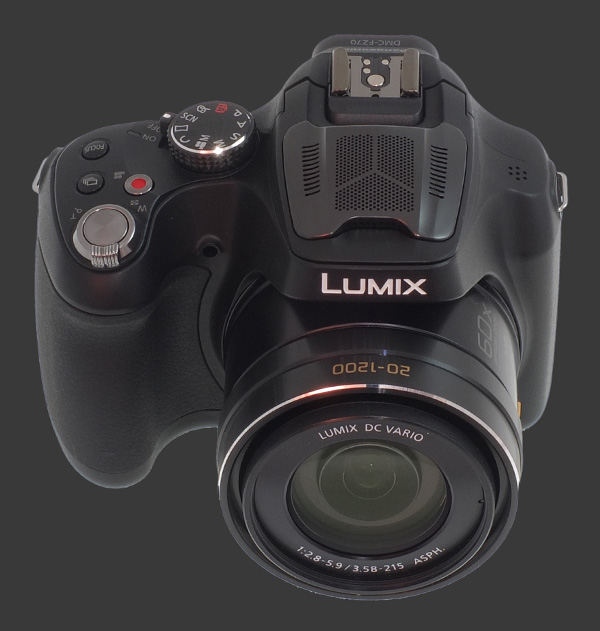
The Panasonic Lumix DMC-FZ70 is a feature-rich ultra-zoom with the widest field-of-view and longest zoom of any fixed-lens camera. Its 60X optical zoom offers dependable image-stabilization and a previously unseen 20-1200mm equivalent range. This versatility is both highly practical and fun.
Inside the FZ70 is a high-resolution 16 megapixels CMOS sensor which can shoot at full-resolution up to 9 FPS and capture full 1080p HD video at 30 FPS or 720p at 60 FPS. The video capability offers PASM manual-controls and a zooming stereo microphone with built-in wind-filter.
Image-quality of this ultra-zoom is good when there is enough light. In such conditions, autofocus is rather fast and locks even quicker with pre-focus enabled. Like all small sensor cameras, low-light makes this Panasonic struggle yet it manages to lock focus on very dim subjects long after most cameras would have given up.
This ultra-zoom has plenty of controls to make it efficient to operate. The actual menu system is rarely needed and the camera generally remains responsive. It rarely gets in the way and seems well thought-out for the most part. The EVF is tiny and low-resolution but, like the LCD, at least shows an accurate preview of exposure when the shutter is half-pressed.
The FZ70 is a good candidate for photography during certain types of travel like tours where people often visit sites in bright daylight and the entire group is moving quickly from place to place. Having an all-in-one camera like this one for such occasions means that lots of photos can be taken with a variety of focal-lengths without slowing others down.
 |
Please Support Neocamera
All information on Neocamera is provided free of charge yet running this website is a huge endeavor. Purchases made via affiliate links found throughout the site help keep it running and up-to-date. There is no additional cost to you, so please consider buying via these links to our affilates:
Thank you for your support!
Panasonic DMC-FZ70 Highlights
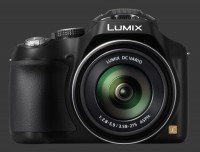
Sensor-Size: 6 x 5mm

Actual size when viewed at 100 DPI
| 16 Megapixels Ultra Zoom | ISO 100-3200 |
| 60X Ultra-Wide Optical Zoom | Shutter 1/2000-8s |
| Built-in Stabilization | Full manual controls, including Manual Focus |
| 0.20" Built-in EVF 200K Pixels | Custom white-balance with 2 axis fine-tuning |
| 9 FPS Drive, 3 Images | Spot-Metering |
| 1920x1080 @ 30 FPS Video Recording | Hot-Shoe |
| 3" LCD 460K Pixels | Lithium-Ion Battery |
| Secure Digital Extended Capacity, Internal Memory |
Updates
2025.11.13

Best Gifts for Photographers in 2025 by Budget
The annual Neocamera Photography Gift Guide updated to 2025. Find great gifts for photographers with any price budget.
2025.07.07

Stellar Photo Recovery Review
Review of Stellar Photo Recovery V12. This Windows and MacOS software can recover photos and videos in a huge number of formats from memory cards, USB drives, SSDs and HHDs.
2025.05.14

Huion Kamvas 13 Gen 3 Review
In-Depth review of the Huion Kamvas 13 Gen 3 Pen Display Tablet for photographers and graphic artists.
2025.01.18

Fujifilm GFX 2025 Lens Roundup
Lens Review roundup of Fujifilm GFX Medium-Format lenses. Quality, performance and handling of the GF20-35mm F/4R WR, GF30mm F/3.5 Tilt-Shift and the GF55mm F/1.7.
2024.11.18

Best 2024 Photography Gifts for Every Budget
Great gifts for photographers and photo enthusiasts selected for every budget among the best products of 2024.
2024.08.07

Eye Protection Tips for Professional Photographers
The four main considerations for professional photographers regarding eyewear.
2024.07.14

Fujifilm X100VI Review
Flagship fixed-lens compact digital camera with a 40 MP sensor and Image-Stabilization, a first for the series. Retro design featuring dual control-dials, plus direct ISO, Shutter-Speed and EC dials. Its hybrid viewfinder can switch between EVF and OVF mode.
2024.05.09

Fujifilm GFX100 II Review
Flagship 102 Megapixels Medium-Format Mirrorless Digital Camera with 8-Stop 5-Axis IBIS, 8 FPS Drive, 8K Video and 400 MP Super-Resolution capture in a weatherproof and freezeproof body with dual control-dials and dual memory-card slots.
2024.04.03

Fujifilm X-T5 Review
Newest Fujifilm flagship boasting a 40 MP APS-C sensor, 5-axis IBIS with 7-stop efficiency, 15 FPS continuous drive, 6.2K Video capture, dual control-dials and dual SDXC UHS-II slots in a sturdy weatherproof and freezeproof body.
2023.11.20

Best Digital Cameras of 2023
Find out which are the Best Digital Cameras of 2023. All the new Mirrorless Digital Cameras from entry-level to high-end professional.
2023.07.10

Fujifilm X-H2 Review
40 Megapixels APS-C Hybrid Mirrorless Digital Camera with 7-stop IBIS. Fastest shutter ever and 8K video capture. Large builtin EVF with 0.8X magnification and 5.8 MP, plus an Eye-Start Sensor. Packed with features and large number of controls in a weatherproof and freezeproof body.
2023.05.07

Sony FE 20-70mm F/4G Review
Review of the unique Sony FE 20-70mm F/4G lens. The optical zoom of this lens spans ultra-wide-angle and medium focal-length coverage, making it one of the most versatile Full-Frame lenses on the market.












